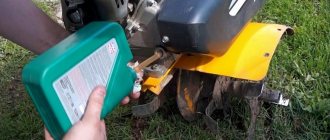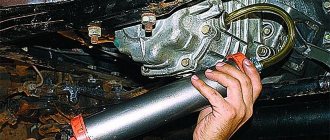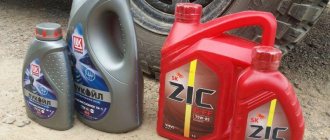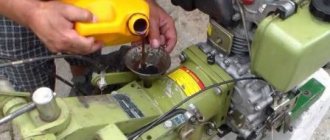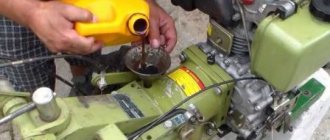Cultivators and walk-behind tractors are reliable helpers in personal plots and farms, designed for processing and cultivating land. Like any other equipment, cultivators require periodic maintenance, during which the oil is changed and other work is carried out as required by the manufacturer's regulations.
Many owners of cultivators do not know what kind of oil to pour into the engine or gearbox of the device. They use the first lubricant they come across, which shortens the life of the equipment. Let's look at what kind of cultivator oil should be poured into two-stroke and four-stroke engines, current specifications, as well as lubrication changes and maintenance.
Differences in oils for cultivators
Regardless of the type and brand of lubricant, it performs the following functions:
- Reduces friction between moving elements, protecting them from wear;
- Protects parts from corrosion;
- Provides heat removal, preventing overheating of friction pairs;
- Cleans the assembly from dirt and foreign particles.
Modern lubricants are distinguished by their intended purpose. Cultivators use motor, transmission and flushing oils.
One of the main parameters that determines the chemical composition, production method, as well as viscosity and performance characteristics is the oil base:
- Mineral grades are natural products obtained by processing and purifying oil from harmful fractions, including sulfur, paraffin, unsaturated and asphaltene-resin compounds. The quality of the finished oil largely depends on the raw materials and its composition. The main disadvantage of mineral motor oils is their low viscosity at low temperatures, which prevents normal engine starting in winter. In addition, the service life of natural varieties is much shorter compared to synthetic lubricants. The main advantage of mineral oil is its affordable price.
- Synthetic varieties are obtained through complex chemical transformations of petroleum products. The resulting composition is characterized by high fluidity, chemical stability and temperature stability. Manufacturers of synthetic oils use additives that improve the performance characteristics of the base oil. Due to the complexity of the production process, synthetic varieties are the most expensive.
- Semi-synthetic varieties are a mixture of mineral and synthetic oils. Such compositions have fairly good resistance to low temperatures - this is an excellent option for regions with temperate climates.
It should be remembered that mixing motor oils with different bases is strictly not recommended - this can lead to an irreversible change in the properties of the mixture, which usually leads to rapid failure of the unit. Also, you should not perform this operation for products with the same base, but from different manufacturers - no one can predict how the additives will interact with each other. Most likely, the consequences will be sad.
Let's move on to the features of lubricants for various components.
For two-stroke internal combustion engines
In the vastness of the USSR, the first two-stroke oil, M-12-TP, appeared in the late 70s. This was caused by the need of logging farms using Druzhba type chainsaws for a specialized lubricant. There are now many two-stroke compounds on the market from domestic and foreign manufacturers, which simplifies the process of choosing the right product.
A characteristic feature of two-stroke engines is the absence of their own lubrication system. This forces you to mix fuel and oil in certain proportions specified by the manufacturer. The resulting mixture is fed into the carburetor, simultaneously lubricating all moving elements. Some modern two-stroke engines implement the principle of separate lubricant supply by a special pump. Mixing with the gasoline-air mixture usually occurs outside the carburetor. Designs are also known in which lubricant is supplied to the bearings of the crank mechanism, and the excess is mixed with the air-fuel mixture and lubricates the cylinder.
How to prepare a motor cultivator for winter storage
An important question for cultivator owners: how to prepare equipment for winter “rest”. The room in which your cultivator will winter should not be dusty or damp. To prepare the machine for long-term downtime, it is necessary to carry out a preservation procedure. All work should be carried out with a cold engine.
Preservation of the motor cultivator should be carried out not only before winter, but also in cases where the unit will not be used for a long time.
Draining fuel
First, try to use up as much fuel as possible; any remaining fuel must be drained from the tank and carburetor. For this, most models have a special drain bolt or plug. Unscrew it, place some kind of fuel container under the carburetor and open the fuel lever. When gasoline flows out, you need to close the hole and the fuel lever. In the fresh air, you need to test start the engine to make sure that there is no fuel left in the carburetor. Let the cultivator idle until it stops completely, this will prevent the accumulation of resins, which can cause poor starting or failure of the equipment.
Old fuel that has been stored for more than 30 days is unusable. Gasoline oxidizes and its tar content increases. The cultivator's carburetor may become clogged if gasoline is not drained for a storage period of more than a month.
You can also change the oil if necessary.
Replacing the spark plug
On most models of motor cultivators, it is necessary to unscrew the spark plug. It is necessary to evaluate its condition and, if faulty, replace it. To do this, disconnect the cap and clean the dirt around the spark plug. Using a spark plug wrench, unscrew the part and inspect carefully. Pay attention to the gap between the electrodes. The appearance indicates not only the serviceability of the spark plug itself, but also the operation of the unit’s engine. If the electrode is covered with a velvety black soot, it should be replaced. Manufacturers usually indicate recommended spark plug models in the instructions. A malfunction of this element can lead to increased fuel consumption, a drop in power, difficulty starting, etc.
A normally functioning spark plug has an electrode gap of 0.7 - 0.8 mm. The electrode is light brown in color with a minimum amount of deposits and soot. There are no traces of oil.
Black carbon deposits, traces of unburnt oil or fuel may indicate engine malfunction.
Shaft lubrication
After unscrewing the spark plug, you need to pour about a tablespoon of engine oil into the cylinder. Slowly pull the starter handle until there is resistance, this will rotate the crankshaft and lubricate the piston rings. At the same time, you will close the engine intake and exhaust valves, protecting the inside of the engine from corrosion.
Advice:
To make it more convenient to pour oil into the cylinder, you can use a 10-20 ml syringe.
Final preparations
It is necessary to bring your cultivator into proper condition. Give it a thorough inspection. Clean the cutters from dirt and grass residues and lubricate them. If the paint has peeled off in some places, it must be cleaned off and these places lubricated. Lubricate all visible controls: levers and cables. Clean the air filter. To save space in your garage, you can remove the cutters and fold the handles.
Now your cultivator is completely ready for a well-deserved rest and will look forward to the start of the new season!
Oil for diesel cultivator
The most productive cultivators and walk-behind tractors designed for working on difficult soils are equipped with diesel engines. The advantages of such devices include reliability and low fuel consumption.
To service garden equipment with a diesel engine, the following types of oils are used, which are classified according to the API standard:
- API CA - suitable for equipment running on high-sulfur diesel fuel under light to medium load conditions. Special additives provide reliable protection against corrosion and effectively remove temperature deposits on cylinder walls. Not recommended for cultivators operating under heavy loads.
- API CB - in composition and properties, this type of oil is an analogue of CA class products. It features special additives that significantly reduce the risk of corrosion on the internal surfaces of the engine.
- API CC are high-quality lubricants that have proven themselves on engines of garden equipment with an air cooling system. The compositions are characterized by stable performance properties regardless of operating temperature. Suitable for mechanisms operating in harsh conditions.
- API CF-2 is distinguished by an additive package that allows the oil to be used in cultivators and walk-behind tractors subject to high loads during operation.
Content:
- Mysterious SAE
- Engine oil SAE 30
- Lubrication features
- Offer from SINTEC
The assortment of auto stores is represented by a wide variety of fuels and lubricants. A significant niche is occupied by motor oil, which, through circulation, protects the engine from overheating and reduces friction of parts, increases the efficiency of antifreeze use. Its importance for the normal operation of the car is difficult to overestimate; it is enough to choose the right product in composition. For this purpose, the lubricant is classified and labeled by viscosity, which is the main characteristic. It determines the quality of the oil film formed on the surface of the rubbing parts of the engine to protect metal surfaces from dry friction, which reduces wear and increases the operating life of the unit. It is important to note that the film must maintain its properties and integrity even under difficult operating conditions and withstand high temperatures and pressure. The lubricity of the oil depends on the viscosity.
Oil for petrol cultivator
As written above, oil for gasoline cultivators differs in the type of base and method of production, which determines the main characteristics and scope of application. The seasonality of the product and its viscosity play an important role. The most widely used are all-season oils that demonstrate high performance regardless of ambient temperature and time of year.
Modern compositions for gasoline engines are divided into the following tolerance groups:
- API SM – was adopted in 2004. Products with this approval are characterized by high performance characteristics.
- API SL - for engines manufactured after 2000. Suitable for engines running on lean mixtures.
- API SJ - for engines manufactured after 1996.
- API SH - for engines manufactured after 1994.
- API SG - for engines manufactured after 1989.
- API SF - for engines manufactured after 1980.
Special care
There are a large number of different walk-behind tractors, each of which has its own characteristics, specific characteristics and other differences, so you can choose exactly the type of equipment for caring for your site that will seem most attractive to you.
However, it is worth considering that, like any other equipment, walk-behind tractors Sadko, Don, Huter, Profi, Plowman, Champion, Carver, Husqvarna, Lifan 6.5 and others need constant care, proper use and good attitude. After all, this unit is very similar to a car, so its care must be consistent.
For more information about the walk-behind tractor, watch the video:
Cultivator engine oil recommended by manufacturers
Let's look at the most famous engines for cultivators, including engines from Honda.
| Characteristics | Engine make and model | |||||
| Honda GX100 | Honda GXV 160 | Robin‑Subaru EX13D | Lifan LF168F-2В | Briggs&Stratton RS Series 485 | Hyundai IC 160 | |
| Power, l. With. | 2,8 | 4,3 | 4,3 | 6,5 | 6,5 | 5.5 |
| Volume, cm3 | 98 | 163 | 126 | 196 | 208 | 163 |
| Torque | 5.7 Nm | 9.6 Nm | 8.1 Nm | 11.0 Nm | 10.17 Nm | 9,6 |
| Oil type | SF or SG; SAE 10W-30 | SF or SG; SAE 10W-30 | SE and higher SAE 10W-30 | SF or SG; SAE 10W-30 | SJ and above SAE 10W-30 | SJ and above SAE 10W-30 |
| Crankcase capacity, l. | 0,4 | 0,65 | 0,6 | 0,65 | 0,6 | 0,5 |
| Dry weight, kg | 10,6 | 13,5 | 14,0 | 16,2 | 15,1 | 13,5 |
Lubrication features
SAE 30 engine oil has high technical characteristics. Designed for operation at temperatures ranging from +5 to +25 °C. The lubricant has a viscosity level of 9.4–12.4 centistokes, which is confirmed experimentally. To do this, the petroleum product is poured into a small container with a hole. The parameter being tested will depend on the time it takes for the oil to completely drain. Advantages of SAE 30 oil:
- stable oil film, necessary to prevent corrosion processes and reduce wear of rubbing parts;
- lack of tendency to foam;
- high alkaline number, which minimizes the formation of soot;
- ensuring optimal cleaning of engine parts and components;
- reliable protection of the motor from overheating and negative processes.
Change of oil
Let's look at the procedure and features of changing oil in cultivators. Regardless of the engine type, it is not recommended to use separate lubricant additives, which are available in large quantities on the market. This may reduce the performance of the composition.
The used product should be disposed of with the least damage to the environment. The optimal solution is to take the old oil to a recycling facility.
In the engine
The first oil change in the cultivator engine is carried out after break-in. This is the name of the process of grinding in moving parts of a device, during which small metal particles enter the lubricant. The duration of the break-in depends on the specific brand of cultivator. Subsequent replacements should be carried out in accordance with the maintenance regulations in the user manual, but at least once a year.
The process of replacing the lubricant in the cultivator engine is quite simple:
- The cultivator must be installed on a horizontal plane and shut down;
- We wait 5-10 minutes for the oil to completely drain into the engine sump;
- Unscrew the crankcase plug, drain the oil into a pre-prepared container;
- Fill in new lubricant. We check the level using a dipstick, and if it is missing, fill the oil up to the control hole.
Important information! When planning the frequency of maintenance, it is necessary to take into account the intensity of the load. If the lubricant has darkened to the color of fuel oil, it should be replaced immediately.
In the gearbox
Changing the oil in the gearbox should also be carried out in accordance with the manufacturer's recommendations.
The order of work is as follows:
- Place the cultivator on stands and turn it off;
- Find and unscrew the drain plug;
- To avoid environmental pollution, the lubricating fluid must be drained into a previously prepared container of suitable volume;
- We wait until the oil completely flows out of the drain hole. Since transmission lubricants have a high viscosity, you will have to wait 5-10 minutes, depending on the outside temperature;
- Tighten the drain plug tightly;
- Unscrew the filler plug;
- Using a funnel, add fresh lubricant.
The level is checked using a dipstick or inspection hole, depending on the design of the cultivator gearbox.
Please note that most modern models come with a dry gearbox, which must be filled with oil after purchase.
Different oils for different temperature conditions
For stable operation of the cultivator, you need to use lubricants that correspond to the operating time of the cultivator. Under different temperature influences, the lubricant behaves differently: when heated, it becomes more liquid, and when cooled, on the contrary, it thickens. Manufacturers, changing the nominal state of lubricants, adapt them to different operating conditions. Therefore, all the variety on the market can be divided into 3 groups:
- Summer engine lubricants. They are initially more viscous, due to which they do not become excessively fluid under conditions of high external temperatures. While maintaining a fairly thick consistency, they adhere more effectively to the surfaces of engine parts and provide reliable protection against friction and wear.
- Winter oils for motor cultivators. The viscosity of such grades is significantly lower, due to which they do not become excessively thick at low temperatures, make it easier to start the engine and more effectively protect it during cold operation.
- All-season varieties. The most common option, characterized by versatility of use. You can fill in this oil for both summer and winter. However, it is undesirable for critically low or high temperatures.
You can understand for which season of operation a particular oil was developed by its marking in accordance with SAE standards. Lubricants of five classes are intended for summer use: 20, 30, 40, 50 and 60. The higher the numerical value here, the higher the lubrication efficiency will be ensured at higher temperatures.
The marking of winter oils according to SAE is distinguished by the addition of the W index after the number (from Winter - “winter”). For the cold season, 6 classes of motor oils are offered - 0W, 5W, 10W, 15W, 20W, 25W. Here, the meaning of the marking is the opposite of the summer standard - the lower the number in front of W, the lower the temperatures at which the material remains fluid.
The designation of all-season lubricants combines both of the above markings. This includes materials designated 5W-30, 5W-40, 10W-30, 10W-40, 15W-40, 20W-50. The first number shows how effectively this oil will work in cold conditions, and the second characterizes its performance at high temperatures.
In addition, attention should be paid to such an indicator as the ratio of viscosity at high temperatures to the shear rate of the lubricant. The values of this parameter are standardized according to the ACEA system. The larger its value, the higher the energy-saving properties of the oil you choose. Accordingly, the more effectively it will protect the engine of your cultivator. Therefore, you need to choose this indicator in proportion to the engine power and the intensity of the work to be done.
In general, when choosing oil for a motor cultivator, it is recommended to follow the manufacturer’s recommendations. For each engine model, certain types and classes of lubricants are recommended, which optimally correspond to the design features and operating parameters of a particular power plant. Moreover, many motorcycle manufacturers, as a rule, recommend the use of lubricants from certain manufacturers. This is often due to marketing interests, but it is still better to adhere to these tips.
In addition, keep in mind that over time the engine will wear out, the gaps will increase - and this can lead to an increase in lubricant consumption. In this case, it is permissible to use oils with a slightly higher viscosity. However, the step must be within SAE class 1 - too viscous oil will only harm the engine.
Is it possible to add car oil?
Owners of gardening equipment often ask the question: “Is it possible to pour automobile oil into the engine of a cultivator or walk-behind tractor?” This topic is especially relevant for vehicle owners who independently carry out repairs and maintenance. Using one brand of oil can reduce the cost of purchasing lubricants.
In fact, it all depends on the brand of the device and the type of engine. Manufacturers of cultivators equipped with four-stroke gasoline engines usually allow the use of API-approved oil. Please refer to your model's technical manual for exact information.
If the cultivator is equipped with a two-stroke engine, the use of regular automobile oil is strictly prohibited. The fact is that lubricant designed for four-stroke engines does not mix well with gasoline, which leads to loss of lubricating properties and accelerated wear of the cylinder-piston group. In addition, the combustion of automobile oil is accompanied by the formation of a large amount of ash, which is deposited on the piston and cylinder walls, clogs the exhaust channels, and also clogs the spark plug electrode.
Signs of a fake
- Label . Manufacturers of counterfeits forget to indicate all the necessary data on the label. Before purchasing car oil, find out what the original label looks like.
- Color . Typically, counterfeit petroleum products are much darker than the real thing.
- Structure . The original lubricant does not leave sediment and does not contain various foreign particles.
- Price . It is suspicious if car oil from a well-known manufacturer costs mere pennies. If the price of a petroleum product is too low, know that it is most likely a fake.
- Paper test . High-quality oil does not leave a visible trace, flowing down a simple piece of paper. A fake leaves a dark trail behind itself.
On the left is fake oil with poor-quality seams and roughness.
Do I need to add oil to gasoline?
The correct answer to this question depends on the type of engine installed on the owner's cultivator. For example, four-stroke engines are designed to use pure gasoline - they do not require preliminary preparation of the fuel mixture.
Oil and gasoline are poured only into two-stroke gasoline engines. In this case, it is necessary to strictly observe the proportion specified by the manufacturer. Otherwise, the engine will operate unstably due to the poor quality of the fuel mixture.
Cultivators running on diesel fuel also do not require such procedures. Diluting diesel fuel with motor oil can lead to dire consequences, including major repairs.
Engine oil SAE 30
SAE 30 is a mineral motor oil for the summer season and warm climates. It is quite viscous, which ensures good engine lubrication with the formation of a dense oil film. The product is suitable for four-stroke gasoline or diesel engines, motorcycle engines and lawn mowers. This lubricant is also used for vintage cars, cars with high mileage and old, worn-out engines. When using SAE 30 oil in temperate climates, you should be careful and replace it in time when the temperature drops. Under such conditions, lubricity is sharply reduced, and in frosty weather the oil will simply freeze. Continued use may result in engine damage.
How to check the level
Checking the lubricant level is a mandatory procedure that should be performed before each engine start. This will help avoid oil starvation of the cultivator components and parts. In addition, the appearance of the fluid will tell an experienced owner a lot about its condition. For example, black color and thick consistency indicate that the lubricant needs to be changed urgently.
Before the procedure, you should install the cultivator on a horizontal platform. An oil dipstick is used as a control tool.
It is recommended to check the level on a cold engine. If the owner has any concerns during operation, it is necessary to turn off the engine and wait 5 minutes. During this time, the lubricating fluid will have time to completely drain into the crankcase.
